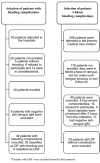Reduced thrombin formation and excessive fibrinolysis are associated with bleeding complications in patients with dengue fever: a case-control study comparing dengue fever patients with and without bleeding manifestations
- PMID: 23890510
- PMCID: PMC3733705
- DOI: 10.1186/1471-2334-13-350
Reduced thrombin formation and excessive fibrinolysis are associated with bleeding complications in patients with dengue fever: a case-control study comparing dengue fever patients with and without bleeding manifestations
Abstract
Background: Dengue cases have been classified according to disease severity into dengue fever (DF) and dengue hemorrhagic fever (DHF). Although DF is considered a non-severe manifestation of dengue, it has been recently demonstrated that DF represents a heterogeneous group of patients with varied clinical complications and grades of severity. Particularly, bleeding complications, commonly associated to DHF, can be detected in half of the patients with DF. Although a frequent complication, the causes of bleedings in DF have not been fully addressed. Thus, the aim of this study was to perform a comprehensive evaluation of possible pathophysiological mechanisms that could contribute to the bleeding tendency observed in patients with DF.
Methods: This is a case-control study that enrolled adults with DF without bleeding and adults with DF and bleeding complications during the defervescence period. Healthy controls were also included. Peripheral blood counts, inflammatory, fibrinolysis and endothelial cell activation markers, and thrombin generation were evaluated in patients and controls.
Results: We included 33 adults with DF without complications, 26 adults with DF and bleeding and 67 healthy controls. Bleeding episodes were mild in 15 (57.6%) and moderate in 11 (42.4%) patients, 8 (30.7%) patients had bleedings in multiple sites. Patients with DF and bleedings had lower platelet counts than DF without bleeding (median = 19,500 vs. 203,500/mm3, P < 0,0001). Levels of TNF-α, thrombomodulin and VWF were significantly increased in the two dengue groups than in healthy controls, but similar between patients with and without bleedings. Plasma levels of tPA and D-dimer were significantly increased in patients with bleedings (median tPA levels were 4.5, 5.2, 11.7 ng/ml, P < 0.0001 and median D-dimer levels were 515.5, 1028 and 1927 ng/ml, P < 0.0001). The thrombin generation test showed that patients with bleeding complications had reduced thrombin formation (total thrombin generated were 3753.4 in controls, 3367.5 in non-bleeding and 2274.5nM in bleeding patients, P < 0.002).
Conclusions: DF can manifest with spontaneous bleedings, which are associated with specific coagulation and fibrinolysis profiles that are not significantly present in DF without this complication. Particularly, thrombocytopenia, excessive fibrinolysis and reduced thrombin formation may contribute to the bleeding manifestations in DF.
Figures




Similar articles
-
Activation of endothelial cells, coagulation and fibrinolysis in children with Dengue virus infection.Thromb Haemost. 2007 Apr;97(4):627-34. Thromb Haemost. 2007. PMID: 17393026
-
Activation of coagulation and fibrinolysis during dengue virus infection.J Med Virol. 2001 Mar;63(3):247-51. doi: 10.1002/1096-9071(200103)63:3<247::aid-jmv1008>3.0.co;2-f. J Med Virol. 2001. PMID: 11170065
-
Prothrombin Time Prolongation was the Most Important Indicator of Severe Bleeding in Children with Severe Dengue Viral Infection.J Trop Pediatr. 2017 Aug 1;63(4):314-320. doi: 10.1093/tropej/fmw097. J Trop Pediatr. 2017. PMID: 28177091
-
Hemostatic derangement in dengue hemorrhagic fever.Thromb Res. 2014 Jan;133(1):10-6. doi: 10.1016/j.thromres.2013.09.028. Epub 2013 Sep 26. Thromb Res. 2014. PMID: 24120237 Review.
-
Factors contributing to the disturbance of coagulation and fibrinolysis in dengue virus infection.J Formos Med Assoc. 2013 Jan;112(1):12-7. doi: 10.1016/j.jfma.2012.10.013. Epub 2012 Nov 20. J Formos Med Assoc. 2013. PMID: 23332424 Review.
Cited by
-
Assessment of aPTT-based clot waveform analysis for the detection of haemostatic changes in different types of infections.Sci Rep. 2020 Aug 25;10(1):14186. doi: 10.1038/s41598-020-71063-1. Sci Rep. 2020. PMID: 32843693 Free PMC article.
-
Microparticles provide a novel biomarker to predict severe clinical outcomes of dengue virus infection.J Virol. 2015 Feb;89(3):1587-607. doi: 10.1128/JVI.02207-14. Epub 2014 Nov 19. J Virol. 2015. PMID: 25410854 Free PMC article.
-
Severe dengue categories as research endpoints-Results from a prospective observational study in hospitalised dengue patients.PLoS Negl Trop Dis. 2020 Mar 4;14(3):e0008076. doi: 10.1371/journal.pntd.0008076. eCollection 2020 Mar. PLoS Negl Trop Dis. 2020. PMID: 32130212 Free PMC article.
-
Dry Socket Etiology, Diagnosis, and Clinical Treatment Techniques.J Korean Assoc Oral Maxillofac Surg. 2018 Apr;44(2):52-58. doi: 10.5125/jkaoms.2018.44.2.52. Epub 2018 Apr 25. J Korean Assoc Oral Maxillofac Surg. 2018. PMID: 29732309 Free PMC article. Review.
-
Platelet Count, D-Dimer, Component Therapy and Dengue Hemorrhagic Fever.Indian J Hematol Blood Transfus. 2018 Apr;34(2):370-371. doi: 10.1007/s12288-017-0861-5. Epub 2017 Sep 26. Indian J Hematol Blood Transfus. 2018. PMID: 29622891 Free PMC article. No abstract available.
References
-
- WHO. Dengue guidelines for diagnosis, treatment, prevention and control. Geneve: World Health Organization; 2009. - PubMed
-
- Wills BA, Oragui EE, Stephens AC, Daramola OA, Dung NM, Loan HT, Chau NV, Chambers M, Stepniewska K, Farrar JJ. et al.Coagulation abnormalities in dengue hemorrhagic Fever: serial investigations in 167 Vietnamese children with Dengue shock syndrome. Clin Infect Dis. 2002;35(3):277–285. doi: 10.1086/341410. - DOI - PubMed
-
- Sosothikul D, Seksarn P, Pongsewalak S, Thisyakorn U, Lusher J. Activation of endothelial cells, coagulation and fibrinolysis in children with Dengue virus infection. Thromb Haemost. 2007;97(4):627–634. - PubMed
Publication types
MeSH terms
Substances
LinkOut - more resources
Full Text Sources
Other Literature Sources
Miscellaneous

